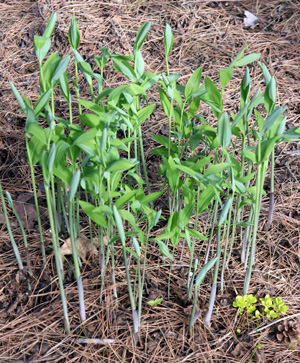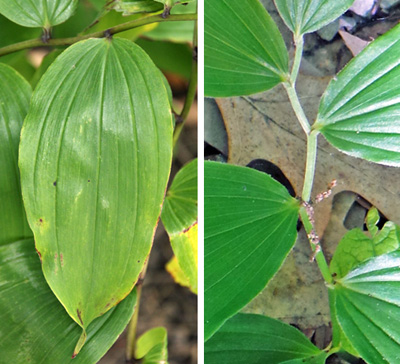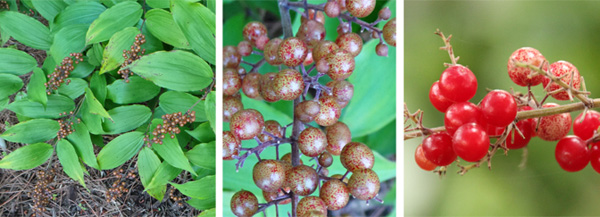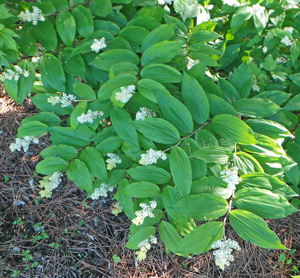
False Solomon’s seal (also called feathery false lily of the valley) is a native woodland plant that gets its common name from its superficial resemblance to Solomon’s seal (Polygonatum spp.). Both are in the lily family (Liliaceae) and are often found together, but are easy to distinguish by where the flowers are produced on the plants. Originally named Smilacina racemosa, this plant that ranges across most of North America north of Mexico in zones 3-9 was moved to the genus Maianthemum a long time ago but the old name is still sometimes used. Native Americans used the root and leaves medicinally and ate the young shoots and processed roots.

As an herbaceous perennial the foliage dies down to the ground each fall and re-emerges in the spring from the stout, fleshy, persistent rhizomes with secondary fibrous roots. The alternate, ovate leaves are produced on 1-3 foot, unbranched arching stems that hold up well through the summer. The slightly hairy, reddish or green stems zigzag slightly between the leaves.

Each smooth, entire leaf is up to 6 inches long with strong parallel veins along its length and usually without a petiole (lower leaves sometimes have short petioles). The foliage may turn yellow to gold in the fall but sometimes just goes brown. The plants often form large colonies from slowly spreads clumps.
In late spring and early summer feathery masses of small white to pale yellow, fragrant flowers are produced in flat panicles at the ends of the stems. Flower clusters can have between 20 and 80 individual flowers. Each ¼” wide star-shaped flower has 6 tepals (petals and sepals that look the same), 6 stamens with yellow anthers and a central pistil. The flowers are pollinated by small bees, flies, and beetles. The flowers are very different from the bell-shaped flowers of Solomon’s seal that hang from each node on the stem.

The flowers are followed by clusters of small rounded berries, each containing a few seeds. They turn from green (or green with purple speckles that gives an overall appearance of a russet color), to translucent red or red and purple-marked when they ripen in late summer or fall. Birds and mice may eat the berries, dispersing the seeds into new areas.


False Solomon’s seal prefers the same conditions as Solomon’s seal: moist, rich, well-drained soils in partial to full shade, but it also tolerates drier, rockier conditions. The roots do not like to be disturbed and flowering will be affected for a year or two if transplanted. Deer will sometimes browse the foliage.
M. racemosum is best used in shaded borders, woodland gardens or native plant gardens and combines well with other shade-loving plants, both native and introduced. The arching stems contrast well with the mounded forms of hosta or the more upright form of ferns. It likes the same conditions as

bleeding heart (Dicentra spectabilis), red columbine (Aqueligia canadensis), woodland phlox (Phlox divaricata), wild ginger (Asarum spp.), and foam flower (Tiarella spp.). It is most effective in clumps of at least 6 stems, although individuals will eventually produce more stems if singles are planted. This species often enters a garden as a volunteer; if that occurs in an inopportune location they can be moved by digging and replacing the entire clump in a new spot (especially when young). Plants can be propagated from fresh seed sown in the fall or by division of the clumps in spring or fall.
This species is similar to M. stellatum (with common names including starry, little, or star-flowered false Solomon’s seal) which is shorter, has fewer but larger flowers, narrower leaves that clasp the stem, and darker, almost black, berries.
– Susan Mahr, University of Wisconsin – Madison
Latest from Wisconsin Yard & Garden
Ask Your Gardening Question
If you’re unable to find the information you need, please submit your gardening question here:





 ▶︎ Watch: Hydrangeas: Know Them and Grow Them
▶︎ Watch: Hydrangeas: Know Them and Grow Them ▶︎ Watch: Fall Bulb Planting
▶︎ Watch: Fall Bulb Planting Aster, Symphyotrichum spp.
Aster, Symphyotrichum spp. Fascinating Fasciation
Fascinating Fasciation


